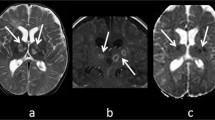Summary
The study is based on follow-up data of 108 patients treated for brain abscess (mean follow-up period 11 years).
The overall incidence of epilepsy was 34% (37% in supratentorial lesions).
The author compared the incidence of several parameters between two groups of patients: those presenting, and those not presenting with epilepsy after brain abscess treatment. Parameters characterized by significantly different incidence in each group were taken into account as possible risk factors influencing the development of epilepsy.
Sex, age of the patient, localisation and size of the abscess are discussed as presumptive risk factors modifying prediction to epilepsy.
The author presents a new concept of epileptic focus formation to explain satisfactorily the results of the study on the basis of pathological mechanisms.
A protocol, which may be useful to evaluate the prediction to epilepsy after brain abscess treatment is proposed.
Similar content being viewed by others
References
Arseni C, Ciurea AV (1981) Brain abscesses. Comments with reference to 810 cases. Zbl Neurochirurgie 42: 77–86
Aydin IH, Aladag MA, Kadioglu HH, Önder A (1988) Clinical analysis of cerebral abscesses. Zbl Neurochirurgie 49: 210–219
Beller AJ, Sahar A, Praiss I (1973) Brain abscess. Review of 89 cases over a period of 30 years. J Neurol Neurosurg Psychiatry 36: 757–768
Bidziński J, Koszewski W (1990) The value of different methods of treatment of brain abscess in the CT era. Acta Neurochir (Wien) 105: 117–120
Bonnal J, Descuns P, Duplay J, Winniger J (1964) Le devenir epileptique des abscès du cerveau. Acta Neurol Psychiat Belg 64: 995–1005
Bradley PJ, Manning KP, Shaw MD (1984) Brain abscess secondary to otitis media. J Laryngol Otol 98 (12): 1185–1191
Choróbski J, Kunicki A (1948) The radical treatment of brain abscess. Surg Gynec Obstet 86: 230–246
Foy PM, Copeland GP, Shaw MDM (1981) The incidence of pooperative seizures. Acta Neurochir (Wien) 55: 253–264
Frank E, Pulver M, de Tribolet N (1986) Expression of class II major histocompability antigens on reactive astrocytes and endothelial cells within the gliosis surrounding metastases and abscesses. J Neuroimmunol 12 (1): 29–36
Goddard GV, McIntyre DC, Leech CK (1969) A permanent change in brain function resulting from daily electrical stimulation. Exp Neurol 25: 295–330
Jooma OV, Pennybacker JB, Tutton GK (1951) Brain abscess: aspiration, drainage, or excision? J Neurol Neurosurg Psychiatry 14: 308–313
Legg NJ, Gupta PC, Scott DF (1973) Epilepsy following cerebral abscess. A clinical and EEG study of 70 patients. Brain 96: 259–268
Morgan H, Wood MW, Murphey F (1973) Experience with 88 consecutive cases of brain abscesses. J Neurosurg 38: 698–704
North JB, Penhall RK, Hanieh A, Hann CS, Challen RG, Frewin DB (1980) Postoperative epilepsy: a double-blind trial of phenytoin after craniotomy. Lancet 1: 384–386
North JB, Penhall RK, Hanieh A, Frewin DB, Taylor WB (1983) Phenytoin and postoperative epilepsy. A double blind study. J Neurosurg 58: 672–677
North JB (1989) Anticonvulsant Prophylaxis in Neurosurgery. (Editorial). Br J Neurosurg 3: 425–428
Northcroft GB, Wyke BD (1957) Seizures following surgical treatment of intracranial abscesses. Neurosurg 14: 249–263
Penfield W (1956) Epileptogenic lesions. Acta Neurol Psychiat Belg 56: 75–88
Ramamurthi B, Logamuthukrishnan K (1975) Brain abscess (Conclusions from a study of 185 cases). Proc Inst Neurol Madras 5: 147–150
Rosenblum ML, Hoff JT, Norman D, Weinstein PR, Pitts LH (1978) Decreased mortality from brain abscesses since advent of computerized tomography. J Neurosurg 49: 658–668
Rosenblum ML, Mampalam TJ, Pons VG (1986) Controversies in the management of brain abscesses. Clin Neurosurg 33: 603–632
Rousseaux M, Lesoin F, Destee A, Jomin M, Petit H (1985) Long term sequelae of hemispheric abscesses as a function of treatment. Acta Neurochir (Wien) 74: 61–67
Scott DF (1985) Left and right cerebral hemisphere differences in the occurrence of epilepsy. Br J Med Psychol 58 (Pt 2): 189–192
Stroobandt G, Zech F, Thauvoy C, Mathurin P, de Nijs C, Gilliard C (1987) Treatment by aspiration of brain abscesses. Acta Neurochir (Wien) 85: 138–147
van Alphen HAM, Dreissen JJR (1976) Brain abscess and subdural empyema: factors influencing mortality and the results of various surgical techniques. J Neurol Neurosurg Psychiatry 39: 481–490
Ward AA Jr (1969) The epileptic neuron: chronic foci in animals and man. In: Japser HH, Ward AA Jr, Pope AL (eds) Basic mechanisms of the epilepsies. Little Brown, Boston, pp 263–268
Ward AA Jr (1975) Theoretical basis for surgical therapy of epilepsy. In: Purpura DP (ed) Advances in neurology, Vol 8. Raven Press, New York
Westcombe DS, Dorsch NWC, Teo Ch (1988) Management of cerebral abscess in adolescents and adults. Experience in the CT-scan era. Acta Neurochir (Wien) 95: 85–89
Zouhar A, Moravek V (1967) Epileptic seizures and EEG findings in patients after brain abscess operations. Cesk Neurol 30: 248–254
Author information
Authors and Affiliations
Rights and permissions
About this article
Cite this article
Koszewski, W. Epilepsy following brain abscess. The evaluation of possible risk factors with emphasis on new concept of epileptic focus formation. Acta neurochir 113, 110–117 (1991). https://doi.org/10.1007/BF01403194
Issue Date:
DOI: https://doi.org/10.1007/BF01403194




